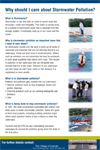Clean Water Starts With Us
Islandia, located at the center of Long Island, does not appear to play an important role in the quality of the water surrounding and under Long Island. But that is not true!
Islandia is home to the Connetquot River headwaters. The river is one of the major rivers of Long Island and carries large water flow into the Great South Bay. Stormwater runoff that enters the river from Islandia’s streets and properties can carry pollutants all the way to the Great South Bay.
Download Posters
 |
 |
 |
 |
« Stormwater Report 2021(PDF)
« Public Notice of Availability (PDF)
« No Drugs Down the Drain Brochure (PDF)
« PSI – Pharmaceutical Disposal Info Sheet (PDF)
« USEPA – How to Dispose of Medicines (PDF)
« Don’t Flush Down the Drain Poster (PDF)
« After the Storm: A Citizen’s Guide to Understanding Stormwater (PDF)
« Stormwater Crossword Puzzle (PDF)
« A Resident’s Guide to Stormwater (PDF)
« Stormwater and the Construction Industry (PDF)
« Municipal Employee Information Guide (PDF)
« Download 2021 Annual Report (PDF)
« Download 2020 Annual Report (PDF)
« Download 2018 Annual Report (PDF)
« Download 2017 Annual Report (PDF)
« Download 2016 Annual Report (PDF)
« Download 2015 Annual Report (PDF)
« Download 2014 Annual Report (PDF)
« Download 2013 Annual Report (PDF)
« Download 2012 Annual Report (PDF)
« Download 2011 Annual Report (PDF)
« Download 2009 Annual Report (PDF)
« Download 2008 Annual Report (PDF)

Stormwater runoff normally is not treated by sewage and wastewater treatment plants. More often than not, end-of-pipe controls are not the best answer for removing pollutants from stormwater runoff. Pollutants in runoff enter our waterways in numerous ways and the best way of control is usually at the pollutant’s source. Sometimes, significant improvements can be made by employing best management practices, or “BMPs”. Proper storage of chemicals, good housekeeping and simply paying attention to what happens during rainfall events can lead to relatively inexpensive ways of preventing pollutants from getting into the runoff in the first place and then our waterways.
The Village encourages all residents to reduce the pollutants they generate by simple measures such as:
- Reduce lawn area and use lawn fertilizers sparingly.
- Never dump anything into storm drain inlets.
- Revegetate bare soil to prevent erosion
- Reduce the use of toxic chemicals and dispose of chemicals properly.
- Check vehicles for leaks and recycle motor oil.
- Pick up after your pet.
- Maintain your septic system and pump when necessary.
- Pick up litter.
All regulated municipalities must obtain a permit from the New York State Department of Environmental Conservation for the discharge of stormwater runoff into their surface waters. As a condition of this permit, regulated municipalities must develop and implement a comprehensive stormwater management program that includes mandated programs and practices in the following six categories:
- Public education and outreach on stormwater impacts.
- Public participation/involvement.
- Illicit discharge detection and elimination.
- Construction site stormwater runoff control.
- Post-construction stormwater management in new development/redevelopment.
- Pollution prevention/good housekeeping for municipal operations.
Our Plan
The Village of Islandia filed a Stormwater Management Plan with the New York State Department of Environmental Conservation that describes what the Town will be doing each year to meet the requirements of the Stormwater Management Program. Each year the Village must prepare and submit an Annual Report describing the steps that the Village enacted during the prior year and the steps to be taken in the coming year. One of our steps for this year is to add a discussion of the program to the Village website.
This year’s report can be obtained at the Village Hall. The Annual Report was reviewed and public comments were received at a public hearing and in writing for ten days following that meeting.
Links Of Interest
Below are websites that provide additional information on the impact of stormwater on Long Island’s resources and additional measures to reduce the pollutants generated.
• New York State’s Stormwater Information
• U.S. EPA Wetlands, Oceans, and Watersheds
• Suffolk County Stormwater Management Program
• Stormwater Manager’s Resource Center




